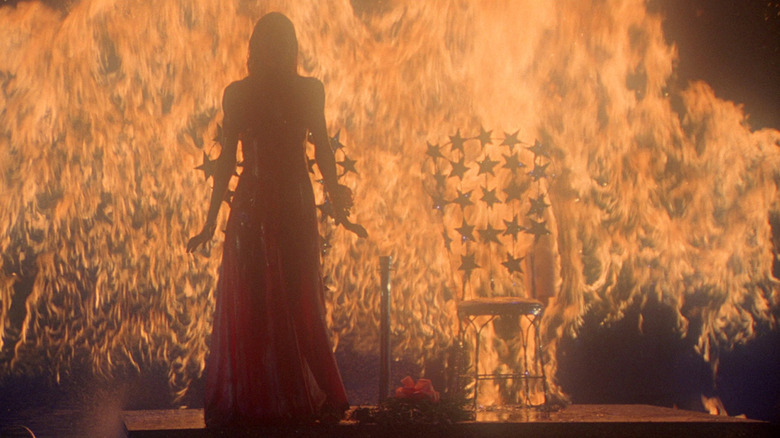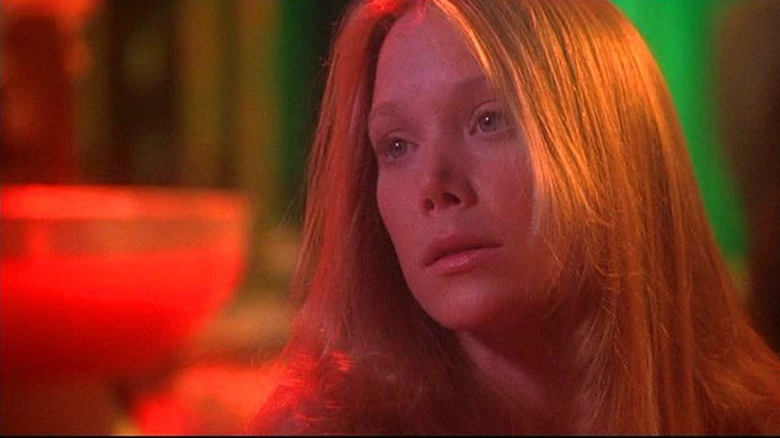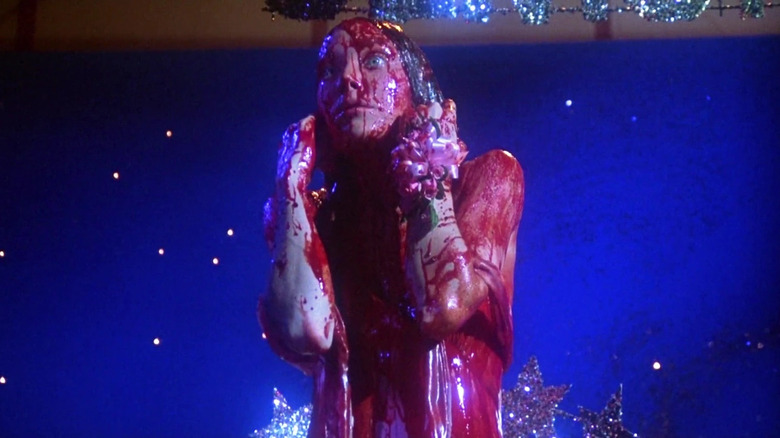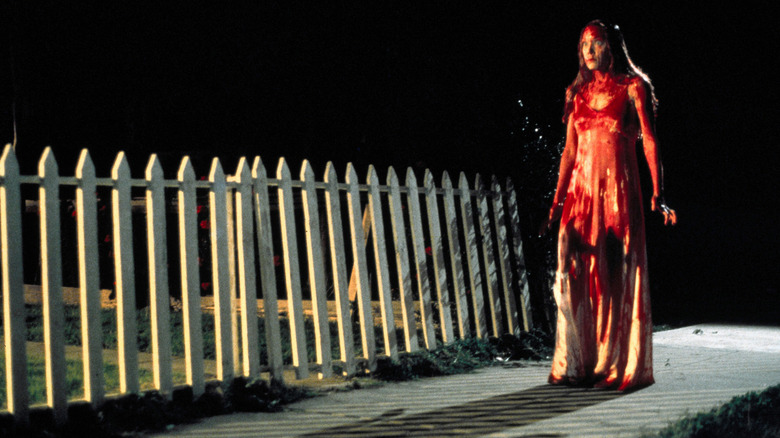How Director Brian De Palma Created The Most Iconic Moment In The First Stephen King Movie
In the 1970s, a guy named Stephen King was living in a trailer with his wife and two kids, struggling to make ends meet. By day, he worked as an English teacher at a high school in Maine. By night, he wrote pulpy short stories that he sold to men's magazines. King, being a guy, primarily wrote stories about guys. Then one day, a friend suggested he write about a female character for a change. So King sat down to write a short story about a girl with telekinetic powers. It wasn't easy: the story goes that King wrote about three pages and then threw the tale in the trash, only to be encouraged to finish it by his wife, Tabitha. Eventually, the story blossomed into a full novel. King would sell the manuscript to Doubleday, and by 1974, Stephen King's debut novel, "Carrie," hit bookshelves in hardcover.
Contrary to legend, it was not an instant blockbuster. However, a year later, a paperback edition of the book arrived and became a bestseller. Stephen King was on his way to becoming one of the most successful writers of all time, and he has Hollywood to partially thank for that. Because a year after "Carrie" dropped in paperback, a film adaptation hit theaters, which in turn increased the sales of the book. Would Stephen King's books have continued to become bestsellers if the first Stephen King movie, "Carrie," had failed? We'll never know for sure, but it's probably safe to assume the film adaptation of "Carrie" certainly helped. "Carrie" was a smash hit with both critics and audiences, and is often hailed as one of the best Stephen King movies.
Sissy Spacek was nominated for an Oscar for Carrie
What makes "Carrie" such a good movie? Many things, but if you had to boil it down, you can probably point to two specific elements: star Sissy Spacek and director Brian De Palma. Spacek, who was nominated for an Oscar for her work, is pitch-perfect as poor, doomed, tormented Carrie White, a shy teenager with telekinesis — the ability to move objects with her mind. Carrie is bullied mercilessly by her classmates. However, one of her fellow students, Sue Snell (Amy Irving) feels bad for picking on Carrie, and eventually arranges things so that her boyfriend Tommy (William Katt) will take Carrie to the prom.
Unfortunately, the other students aren't as remorseful as Sue. They plot a devious plan to get Carrie crowned prom queen — only to then dump a bucket of pig's blood on Carrie's head. Carrie's mother, a religious fanatic played by Piper Laurie (who was also nominated for an Oscar for the film), warned Carrie that the students would laugh at her — and that's exactly what happens. The entire prom, including teachers acting as chaperones, points and laughs at the blood-drenched Carrie — and that's the final straw. Carrie snaps and uses her abilities to tear the gym where the prom is held apart, killing pretty much everyone.
This big climactic massacre is the signature set piece for the film. And that's where Brian De Palma comes in.
Brian De Palma
Brian De Palma is a signature stylist. Heavily influenced by Hitchcock, De Palma's films are often voyeuristic in the way he shoots them. The filmmaker also has little "tricks" he frequently employs, like long tracking shots and split-screens. Some folks have accused De Palma of embracing style over substance, but I'd argue that with De Palma, the style is the substance. The precise, unique, stylish filmmaking on display is what makes many of his films so special. As Pauline Kael wrote in her review of "Carrie,"
"The director, Brian De Palma, has mastered a teasing style—a perverse mixture of comedy and horror and tension, like that of Hitchcock or Polanski, but with a lulling sensuousness. He builds our apprehensions languorously, softening us for the kill. You know you're being manipulated, but he works in such a literal way and with so much candor that you have the pleasure of observing how he affects your susceptibilities even while you're going into shock."
De Palma was turned onto "Carrie" by a friend, who recommended the book to him. Working with a script by Lawrence D. Cohen, De Palma stripped King's novel, which is told in non-linear epistolary fashion, down to its essence: the story of a tormented girl who gets bloody revenge on those who bullied her. The set-up might be simple, and the budget may have been low (about $1.8 million), but De Palma stil pulled out all the stops to create the film's grand finale.
Split-screen and real fire in Carrie
To showcase Carrie using her powers to lay waste to the prom, De Palma relied on split-screen. Speaking with the magazine Cinefantastique in 1977 (via Jessie Horsting's book "Stephen King at the Movies"), De Palma said: "I felt the destruction had to be shown in split-screen, because how many times could you cut from Carrie to things moving around? You can overdo that. It's a dead cinematic device. So, I thought I would split screen."
De Palma spent about six weeks cutting the sequence together with split-screen, but something was off. "I put it all together and it lasted five minutes, and it was just too complicated," the filmmaker said. "Also, you lost a lot of visceral punch from full-screen adion." De Palma and editor Paul Hirsch then went back and "proceeded to pull out of the split screen and use it just when we precisely needed it."
As part of her revenge, Carrie electrocutes some people to death — which in turn starts a fire. Since "Carrie" was made before the age of CGI, real fire was used. They set the set ablaze, and then star Sissy Spacek was instructed to stand among the flames. Such a task might seem daunting, but Spacek embraced the moment. In "Stephen King at the Movies," she's quoted as saying: "I was Carrie. Fire couldn't hurt me. I stayed until my eyebrows got singed."
The results speak for themselves: if you think of the "Carrie" movie, the first thing that comes to mind is that big, climactic prom scene, with all its sound and fury (and fire). It's iconic for a reason.



